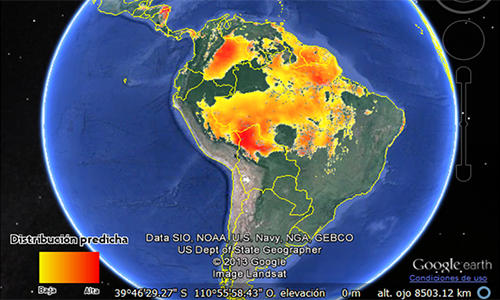Science 2.0: Species experts help to improve distribution models through Google Earth mapping tool

Botanist, forester and other expert opinions should be used to validate and fine-tune the outcomes of the popular environmental envelope modeling tool, says a new paper co-written by Bioversity researchers.
Botanist, forester and other expert opinions should be used to validate and fine-tune the outcomes of the popular environmental envelope modeling (EEM) tool, says a new paper published on Applied Vegetation Science. This EEM approach is used to predict the likely or expected geographic distribution of species and is widely applied in ecological and biodiversity conservation studies.
"It is important to understand species distribution to the best of our abilities because without this knowledge we cannot know where to conserve them," said Maarten van Zonneveld, principal author of Application of consensus theory to formalize expert evaluations of plant species distribution models and an Associate Scientist at Bioversity International.
EEM helps to improve our understanding of species' distributions, but current evaluation methods do not necessarily reflect the model’s true performance; neither do they indicate how useful the models are for use in the field. Often judged as subjective, expert-based opinions are rarely valued for what they’re worth, say the authors of the paper.
"With my colleagues at Bioversity International and partners, we wanted to develop a method that would formalize expert opinions and help improve distribution models," explained Maarten van Zonneveld.
"The cultural consensus theory developed by A. Kimball Romney in the late 80s provides an approach to formalize expert knowledge on the basis of agreement between specialists. We used it to estimate the confidence of expert model validations and to rate model quality." explained Jacob van Etten, Theme Leader, Adaptation to Climate Change, at Bioversity International and one of the co-authors.
"We asked experts for feedback through a tool that I, personally, find fun: Google Earth. Based on it we developed an online validation tool that makes it possible to consult species specialists remotely. The tool uses freely available software and can be used and improved by anyone," said Maarten van Zonneveld.
"Its possibilities are infinite: it can be potentially used for hundreds of tree species and all types of organisms and engage many experts around the world in validating and improving species distribution maps."
The authors of the paper had specialists use the newly developed Google Earth tool to evaluate model outcomes mapping the distribution of five socio-economically important tree species native to Latin America and the Caribbean: cherimoya (Annona cherimola Mill.), peach palm (Bactris gasipaes Kunth), Brazil nut (Bertholletia excelsa Bonpl.), Spanish cedar (Cedrela odorata L.) and rauli Beech (Nothofagus nervosa Phil.). These are among the species included in the MAPFORGEN project, which aims to evaluate the conservation status of 100 socio-economically important woody species native to Latin America and the Caribbean.
"The experts were fairly positive about the distribution model outcomes but they did find some limitations, especially at the local scale at which most experts work. We suggest that to get better results, EEM requires the inclusion of better environmental layers," said Maarten van Zonneveld. At the same time, further involvement of local and international species experts in distribution modeling would help improve the understanding of species occurrence and the application of EEM by them and their colleagues involved in conservation planning.
Read the paper here.
This study was carried out within the framework of Bioversity’s project ‘Strengthening Regional Collaboration in Conservation and Sustainable Use of Forest Genetic Resources in Latin America and Sub-Saharan Africa’, financed by the Instituto Nacional de Investigación y Tecnología Agraria y Alimentaria (INIA), Spain.
Bioversity International’s research on forest genetic resources contributes to the CGIAR Research Program on Forests, Trees and Agroforestry: Livelihoods, Landscapes and Governance.
